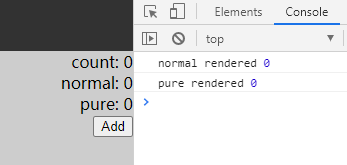
在 React 类组件中,如果状态(state)发生变化,便会触发组件的重新渲染(执行 render 方法),并且是包括所有子组件在内的全部重渲染,无论某些子组件是否有用到 state 中的值;但有些时候部分子组件计算或渲染工作量较大,并且只做一些情况单一的展示工作,那么在更新状态时对其的渲染,便是额外的性能负担,所以需要寻求一些优化手段;
shouldComponentUpdate 是 React 的生命周期函数之一,它会在每次渲染(render)之前被调用,并且根据该函数的返回值(true/false)来决定是否调用渲染函数(return true 触发渲染,return false 阻止渲染),但是组件的首次渲染或者调用 forceUpdate() 方法时不会触发调用 shouldComponentUpdate 方法;该生命周期函数的默认行为是在每次 state 发生变化时触发重新渲染,如果自行声明该函数会覆盖这一默认行为,需要自行判断 state 的变化以决定是否重新渲染;
shouldComponentUpdate 方法接收两个传参:(nextProps, nextState),分别表示变化后的 props(组件的参数) 和 state(组件的状态);
class MyComponent extends React.Component {
state = { count: 0 };
shouldComponentUpdate(nextProps, nextState) {
// 无需手动更新 state 值,组件会自动更新
// this.setState({ ...nextState });
if (nextState.count <= 3) {
// count 值大于 3 后,组件便不再更新
return true;
} else {
return false;
}
}
render() {
const { count } = this.state;
return (
<button onClick={() => this.setState({ count: count + 1 })}>
{count}
</button>
);
}
}
React.PureComponent 类似于我们常用的 React.Component,区别在于 PureComponent 的内置 shouldComponentUpdate 逻辑,它会同时对 props 和 state 的变化前和变化后的值进行浅对比,如果都没发生变化则会跳过重渲染,相当于多了一层 props 对比;下面通过一个简单的例子来对比这两种组件的效果差异;
假设有一个计数器,点击按钮增加计数,并用两种组件渲染计数值:
class Counter extends React.Component {
state = { count: 0 };
render() {
const { count } = this.state;
return (
<div style={{ float: "right", textAlign: 'right' }}>
<div>count: {count}</div>
<CountText count={count > 2 ? count : 0} />
<ConstText count={count > 2 ? count : 0} />
<button onClick={() => this.setState({ count: count + 1 })}>Add</button>
</div>
);
}
}
// 普通组件
class CountText extends React.Component {
render() {
const { count } = this.props;
console.log('normal rendered', count);
return <div>normal: {count}</div>;
}
}
// “纯”组件
class ConstText extends React.PureComponent {
render() {
const { count } = this.props;
console.log('pure rendered', count);
return <div>pure: {count}</div>;
}
}
初次渲染的效果图与输出如下,页面初始化时普通组件与纯组件都会进行一次渲染:

第一次和第二次点击按钮后,可以看到都只有普通组件触发了渲染,即使组件每次接收的 props 值 count 都没有发生变化:
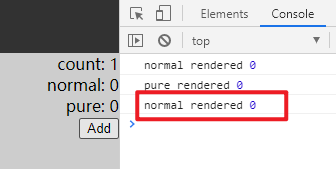
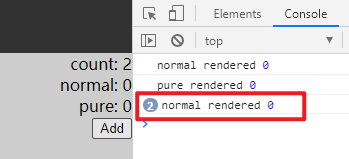
在第三次点击按钮后,由于 props 的传入值发生了改变,因此纯组件也触发了重渲染,页面内容正常更新:
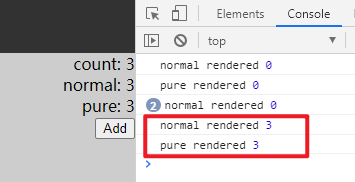
可以看到 PureComponent 确实可以在传入 props 值没有变化时避免重新渲染,在一些场景下优化性能,但是这也是使用 PureComponent 的一个前提,即需要组件在相同 props 传入值的情况下总会有相同的渲染内容,也就是纯组件中 Pure 的含义所在,它有些类似纯函数的定义(传入相同的参数执行后,总会得到相同的返回值);
从另一个方面来说,就是 PureComponent 跳过渲染时,它的所有子组件也会跳过渲染,即使子组件应被更新,所以需要保证纯组件的所有子组件也都是纯组件;举个例子,下面的纯组件包含一个展示当前时间的子组件:
class Counter extends React.Component {
state = { count: 0 };
render() {
const { count } = this.state;
return (
<div style={{ float: "right", textAlign: 'right' }}>
<div>count: {count}</div>
<ConstText count={count > 2 ? count : 0} />
<button onClick={() => this.setState({ count: count + 1 })}>Add</button>
</div>
);
}
}
// “纯”组件
class ConstText extends React.PureComponent {
render() {
const { count } = this.props;
const d = new Date();
const time = `${d.getHours()}: ${d.getMinutes()}: ${d.getSeconds()}`;
console.log('pure rendered', count);
return (
<div>
pure: {count}
<ConstChild time={time} />
</div>
);
}
}
// 展示时间的子组件
class ConstChild extends React.Component {
render() {
const { time } = this.props;
console.log('child rendered', time);
return <div>{time}</div>
}
}
页面初始化时:
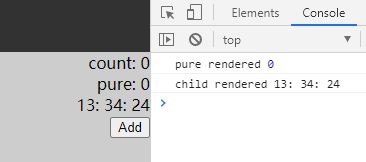
前两次点击按钮后:
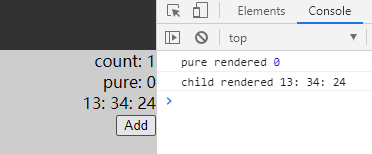
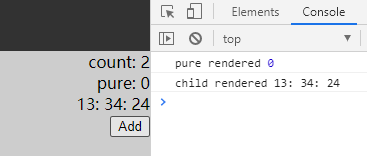
此时纯组件和其子组件都未触发更新,在第三次点击后,才同时触发更新:
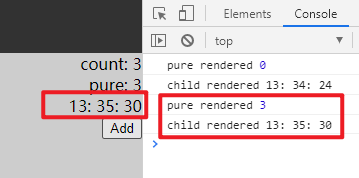
最开始有提到 PureComponent 是对 props 的变化前后的值进行浅对比来决定是否重渲染组件,实际上就是对每个 props 值进行基本的值对比,如果值类型是复杂类型,如引用类型(对象),并不会深入遍历每个属性的变化,下面改造一下上面的示例,让传入纯组件的 props 变成一个引用对象:
class Counter extends React.Component {
state = { count: 0 };
obj = { num: [0] };
handleAdd() {
const newCount = this.state.count + 1;
this.setState({ count: newCount });
this.obj.num[0] = newCount;
}
render() {
const { count } = this.state;
console.log('Counter rendered', count, JSON.stringify(this.obj));
return (
<div style={{ float: "right", textAlign: 'right' }}>
<div>count: {count}</div>
<ConstText count={this.obj} />
<button onClick={() => this.handleAdd()}>Add</button>
</div>
);
}
}
class ConstText extends React.PureComponent {
render() {
const { count: { num: [count] } } = this.props;
console.log('pure rendered', count);
return <div>pure: {count}</div>;
}
}
首次初始化后的结果:
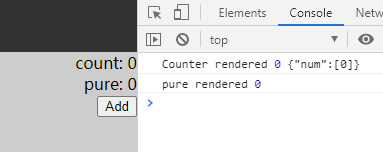
依次点击三次后的结果:
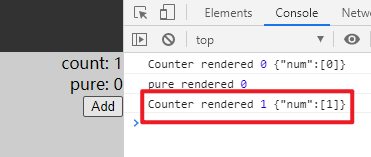
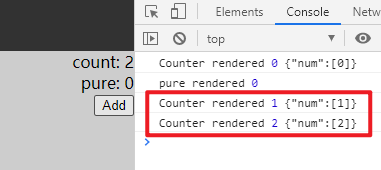
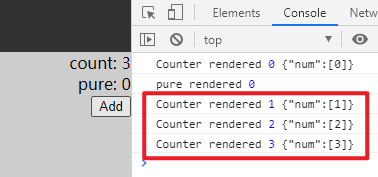
可以看到其实每次传入纯组件的 props 的实际值都有发生变化,但是由于是引用类型,所以组件并没有识别到这一变化,永远跳过了组件更新;因此如果遇到复杂数据结构的情况,尽量使用 state,因为 state 由于自身的特性和规则,每次变化后的值都是一个全新的值;
当然,还有一种特殊情况,如果在组件中使用了 Render prop 或类似的形式,即 props 的值是一个返回某个值的函数,如:
<Counter count={() => 3} />
那么即使每次函数实际执行的值都是相同的,也都会触发渲染,因为这个函数本身每次都会被判断为一个新值,使得性能优化失效;
React.memo 是一个类似 PureComponent 的高阶组件,只不过它用于函数组件,而 PureComponent 用于类(class)组件,但二者的实际展示与优化效果是一致的,下面是两种组件形式的写法:
// 类组件
class ConstText1 extends React.PureComponent {
render() {
const { count } = this.props;
console.log('pure rendered', count);
return <div>pure: {count}</div>;
}
}
// 函数组件
const ConstText2 = React.memo(function(props) {
const { count } = props;
console.log('const rendered', count);
return <div>{count}</div>
});